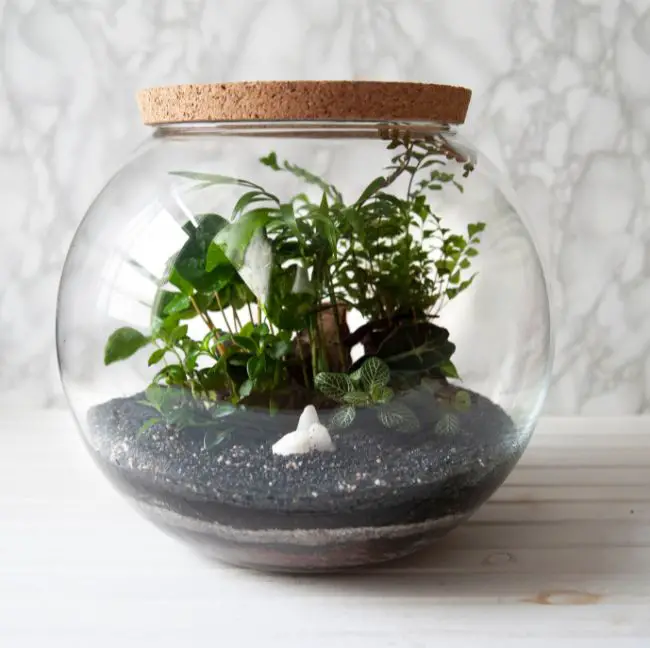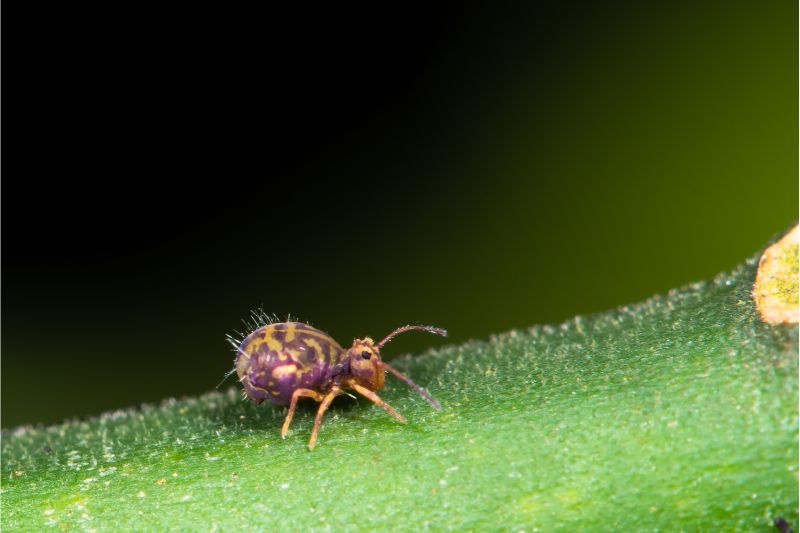This page may contain affiliate links that allow us to make a small commission from qualifying purchases (at no extra cost to yourself). We appreciate your support.
The planet is filled with insects. The news is full of headlines about the essential role pollinators such as bees play in our ecosystem. Gardeners talk about earthworms as if they were tiny deities. But then there are the obnoxious bugs that spoil crops and picnics. Thus, there is debate over bugs in closed terrariums. Pollinators won’t be needed for non-flowering plants. But will other insects help or hurt?
Closed terrariums do not require insects or bugs. However, mold is a common enemy of terrariums, and springtails eat it. Pill bugs and millipedes are helpful, too, as they eat decaying matter. However, other bugs, such as spiders, may not last in a closed terrarium due to lack of food.
Pests can wreak havoc on a closed terrarium. Thus, gardeners wear gloves and often buy the potting mix, charcoal, and other organic matter to ensure it is devoid of critters. In addition, all containers are cleaned thoroughly before use. Thus, the chances of bugs getting in are low. Nor is the low fertility soil ideal for earthworms. But some gardeners want insects in their terrarium.
Do Closed Terrariums Need Insects?

Closed terrariums do not require insects or bugs. Care from the gardener can see to the terrarium’s needs. Gardeners should do the following when creating and maintaining their terrarium to avoid pests:
- Wear gloves
- Use sterile scissors and instruments
- Avoid using soil from the garden
- Buy potting mix and other matter
- Ensure the container is freshly clean before use
- Remove as much soil as possible from plants before introducing them to the terrarium
These steps will reduce the chances of pests getting into the terrarium. Placing a grated screen over the opening during airings will also help keep critters out.
Gardeners can also use a sterile chopstick to fluff up the terrarium’s soil if it has become compact.
Dealing With Mold In A Closed Terrarium
Mold can develop in a closed terrarium even if the gardener has been meticulous about hygiene. Spores too small to be seen can drift in during airings or will have hitched undetected on a plant. These spores rapidly flourish in the humid terrarium.
Thus, gardeners must take care to remove any signs of mold. Cotton buds or gauze are perfect for spot cleaning the jar, bark, stems, and some leaves.
If a leaf is damaged by mold, the gardener should snip it off and remove it from the terrarium.
Dealing With Fungus In A Closed Terrarium
Fungus is not always a problem. Mushrooms, for example, can be an eye-catching addition. However, fungus that is harming the plants or growing on the sides of the terrarium should be removed. Gardeners can use cotton buds and gauze, just as they do with mold. They should also snip off ruined leaves.
Using a fungicide must be done with caution. Toxic chemicals can harm moss and other plants. Fungicides to avoid include:
- Copper-based
- Bacillus Subtilis
- Quantaray ammonium
- Dimethyl Benzyl
- Ammonium chloride
If you are desperate, the following fungicides are safer than the above:
- Sulfur based
- Neem extract
- Tebuconazole
- Chlorothalonil
Always check labels and ingredients and see if they are suitable for your plants. Before treating the entire terrarium, use a small amount to see if the plants can handle it. Only apply it at night, so sunlight won’t cause the chemicals to burn the plants.
4 Beneficial Insects And Bugs For Closed Terrariums
While insects and bugs are not necessary for a closed terrarium, they can be beneficial. Adding one or a few of the following can keep your terrarium healthier and reduce the amount of work required by the gardener.
1. Springtails For Closed Terrariums

Springtails are the most popular critter added to closed terrariums. They are a type of Entognatha, a class of ametabolous arthropods with no wings. These tiny creatures are between 1/16 to 1/8 of an inch long and are white or grey.
Springtails act like cleaners for a terrarium. They feed on a variety of useful substances, including:
- Fungi
- Algae
- Pollen
- Microorganisms
- Decaying matter
Springtails come in two main varieties: temperate and tropical. Temperate springtails are ideal for temperatures 65 to 85F (18-29C). Tropical springtails are for your warmer closed terrariums.
2. Millipedes For Closed Terrariums

Millipedes can be helpful for larger closed terrariums with at least 4 to 6 inches of substrate. They need room to dig and hide. They are helpful because they eat old leaves and decaying matter.
There are over 12,000 varieties of these many-legged insects, and they range in size and climate preferences. It is best to select those on the smaller side and suit the temperature of your terrarium. Also, you might have to give them bits of fruit or vegetables from time to time to supplement their diet.
3. Woodlice For Closed Terrariums

Woodlice, such as the common pill bug (sow bug), are an easy addition to a closed terrarium. They control their population to suit their environment and will happily munch away at decaying debris and keep your terrarium clean.
Most people just find a few around their house or garden and toss them in. However, if you are buying them, look for the word “isopods.” Woodlice are a type of isopod. Also, be aware that most woodlice can’t curl up into a tight ball. It’s only the common pill bug that has such talent. But even the less flexible kinds will keep your terrarium tidy.
4. Worms For Closed Terrariums

Worms can live in larger closed terrariums. However, like millipedes, they will require at least 4 to 6 inches of substrate and may need extra food due to the low nutrient soil. There are many types of worms, and the smaller varieties are best for terrariums. They are good for keeping the substrate aerated.
However, some terrarium gardeners do not like the “messy” substrate worms can create. They can also leave smear marks on the walls. These can be removed with cotton buds or gauze. However, not everyone wants the bother. If you already have one or two of the above critters, they will also ensure the substrate is aerated without requiring as much room.
Conclusion
Insects and bugs are not required for a healthy and happy terrarium. However, certain critters can prevent mold and fungus from flourishing. So while insects and bugs are not a must, they might make maintaining your terrarium easier.

Meet Brad, the creator behind Vivarium Vibes, where his deep connection with nature and animals truly comes to life.
